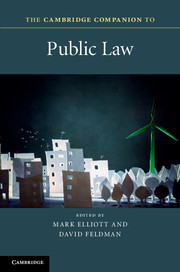Book contents
- Frontmatter
- Contents
- Notes on Contributors
- Introduction
- 1 The distinctiveness of public law
- 2 The politics of public law
- 3 The rule of law in public law
- 4 Legislative supremacy in a multidimensional constitution
- 5 The politics of accountability
- 6 Rights and democracy in UK public law
- 7 Public law values in the common law
- 8 Public law and public laws
- 9 Public law and privatisation
- 10 State architecture: subsidiarity, devolution, federalism and independence
- 11 Soft law never dies
- 12 The impact of public law litigation
- 13 Designing and operating constitutions in global context
- Index
- References
13 - Designing and operating constitutions in global context
Published online by Cambridge University Press: 05 September 2015
- Frontmatter
- Contents
- Notes on Contributors
- Introduction
- 1 The distinctiveness of public law
- 2 The politics of public law
- 3 The rule of law in public law
- 4 Legislative supremacy in a multidimensional constitution
- 5 The politics of accountability
- 6 Rights and democracy in UK public law
- 7 Public law values in the common law
- 8 Public law and public laws
- 9 Public law and privatisation
- 10 State architecture: subsidiarity, devolution, federalism and independence
- 11 Soft law never dies
- 12 The impact of public law litigation
- 13 Designing and operating constitutions in global context
- Index
- References
Summary
Introduction
The contemporary concept of a constitution can be traced to the instruments so named that came into effect in the United States and France at the end of the eighteenth century, in each case in the wake of revolution. Over the century that followed, a constitution became widely accepted as a single written document that prescribes the key elements of a system of government and that derives its authority from a sovereign people. In time, it became more clearly established that a constitution is superior law, distinguished from ordinary law by the manner in which it is made and changed. Over the course of the twentieth century, it became widely accepted that constitutions can be enforced through courts, even at the expense of ordinary law, although the arrangements for doing so varied significantly, in accordance with the differing logic that underpinned them.
While these generalisations are broadly accurate, at least two caveats are necessary. The ideas inherent in the concept of a constitution were not born in a vacuum at the end of the eighteenth century but had a long gestation in Europe, prompted in part by constitutional developments in seventeenth-century Britain, with long roots in the ancient world. Nor do all states have constitutions that match all facets of the modern conception, even now. In the United Kingdom, the Constitution remains an accumulation of laws, principles and practices. In New Zealand, the Constitution Act 1986 can be altered in the same way as ordinary law. There is no judicial review of the constitutional validity of national legislation in, for example, the Netherlands, Ethiopia and Switzerland, although the alternatives and the rationales for them differ. Nevertheless, at least for the moment, the general features of a constitution are sufficiently settled to provide a standard by reference to which exceptional cases can be identified and explained. Constitutions broadly in this form spread across Europe and Latin America in the first part of the nineteenth century and reached parts of Africa, the Middle East, Asia and the Pacific by the end of the century. They continued to proliferate in the twentieth century, in line with the increase in the number of independent states.
- Type
- Chapter
- Information
- The Cambridge Companion to Public Law , pp. 256 - 274Publisher: Cambridge University PressPrint publication year: 2015



